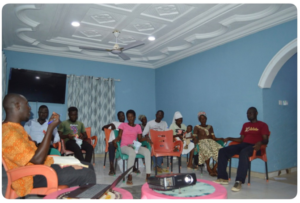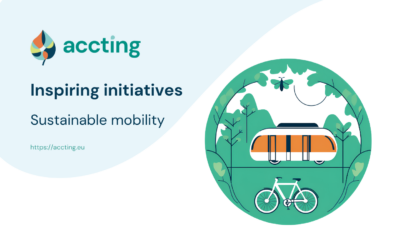In many countries in the Global South, the active involvement of local communities, including the most vulnerable groups, has long become a standard approach to managing the effects of climate change-related natural disasters. Examples of this approach include the Guide to community-based disaster risk reduction in Central Asia (2006) from UNDRR (United Nations Office for Disaster Risk Reduction), and the more recent Community-based flood management tool (2017) from APFM/Associated Programme on Flood Management, promoted by the Global Water Partnership and the World Meteorological Association.

Committee members at Bongo Kukua (Ghana) meeting to draft the Community Flood and Drought Management Plan [1]
The same cannot be said for European countries. Here, partly due to the recent occurrence of extreme weather phenomena, the topic is finally gaining momentum. However, participatory approaches focusing on the groups most exposed to the (direct and indirect) risks of emergent and long-standing climate-related disasters remain less widespread.
Mapping European bottom-up initiatives
The ACCTING project has been seeking to map bottom-up initiatives in European countries. Some have emerged that do indeed resonate with the examples given before. In particular, some of the mapped initiatives capture the dual perspective of ACCTING’s first research line on risk management and vulnerable groups:
• On the one hand, and in line with the environmental justice framework [2], this perspective stresses the increase of inequalities as a consequence of natural disasters, because vulnerable groups are less able to mobilise material, social, and emotional resources to cope with difficult situations.
• On the other hand, it acknowledges that vulnerable people, exposed to different types of social and environmental risks, are crucial actors in the monitoring of the territory in which they live and in the mitigation of the effects of natural disasters. Elderly people, for instance, have been highlighted as crucial actors in preparedness and response to disasters in Europe, because of their knowledge of the territory and their memories of past calamitous events (See the H2020 CARISMAND project).
Different types of activities
Looking closer, the practices that are emerging from the mapping can be traced to three general categories:
1. In the first, integrated systems are built between the public sector and citizens in the management of disasters. Here, citizens belonging to different vulnerable groups are an integral part of planning, monitoring, management and dissemination activities (see for instance the integration of volunteering in civil defence systems, like in this Italian example that was started after the great flooding of Florence in 1966).
2. In the second, citizens’ groups and associations are independently promoting protection activities with respect to natural risks (generally focusing on emerging risks) in specific parts of their territory (see for instance the Akyaka Disaster Volunteers in Turkey, which started as a response to the devastating wildfires in 2021).
3. In the third, we find a few cases of protection activities initiated by groups of residents, which are not sanctioned by local authorities. It is the case, for instance, of the flood embankments which were built and funded through a collection from citizens in a municipality in Not all legal permissions have been obtained yet, so the initiative is technically considered “illegal”.
The mobilisation of the concerned actors within local communities represents a promising perspective for better management and mitigation of climate disaster effects. The diversification of involved actors and strategies in better addressing both long-standing natural disasters and the new ones connected to climate change, bringing together many areas of expertise and different viewpoints. Through the ACCTING project, we hope to assess the effectiveness of this approach.
[1] Reproduced courtesy of the Organisation for Indigenous Initiative and Sustainability Ghana (ORGIIS-GHANA) – Photo taken as part of the activities of the Volta Basin Flood and Drought management program, coordinated by WMO together with VBA and GWP-AO, with the participation of K&I.
[2] Timmons Roberts, J., Pellow, D., & Mohai, P. (2018). Environmental justice. In Environment and Society (pp. 233-255). Palgrave Macmillan, Cham.
About the authors
 Marina Cacace, social researcher at Knowledge & Innovation, has been long focusing on gender studies, and particularly science-society relations from a gender perspective. She has conducted several projects on gender equality in research institutions, while her research interests also include poverty and social exclusion and the application of the complexity perspective to evaluation activities.
Marina Cacace, social researcher at Knowledge & Innovation, has been long focusing on gender studies, and particularly science-society relations from a gender perspective. She has conducted several projects on gender equality in research institutions, while her research interests also include poverty and social exclusion and the application of the complexity perspective to evaluation activities.
 Gabriele Quinti, socio-economist and statistical methodologist at Knowledge & Innovation, has carried out studies, institutional capacity-building and evaluation activities worldwide on the topic of climate change (e.g., energy transition, natural hazards management), as well as research and policy analyses in the field of the eradication of poverty and social exclusion.
Gabriele Quinti, socio-economist and statistical methodologist at Knowledge & Innovation, has carried out studies, institutional capacity-building and evaluation activities worldwide on the topic of climate change (e.g., energy transition, natural hazards management), as well as research and policy analyses in the field of the eradication of poverty and social exclusion.


